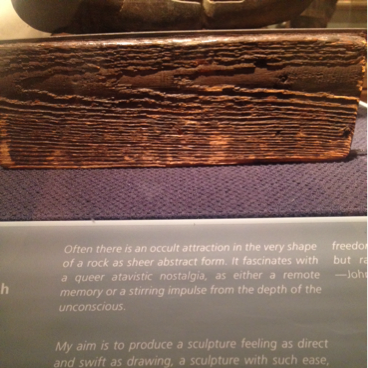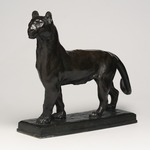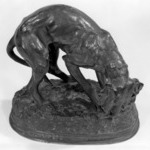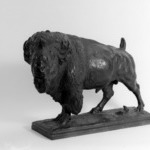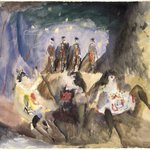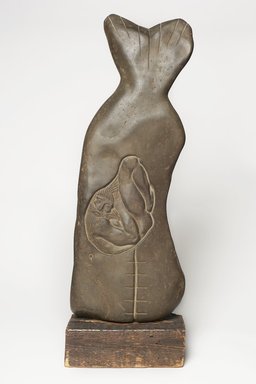

John B. Flannagan (American, 1895–1942). Jonah and the Whale: Rebirth Motif, 1937. Bluestone with wood base, 33 1/2 × 11 1/4 × 6 in., 61.5 lb. (85.1 × 28.6 × 15.2 cm, 27.9kg). Brooklyn Museum, Bequest of Edith and Milton Lowenthal, 1992.11.12a-b (Photo: Brooklyn Museum, 1992.11.12_front_PS11.jpg)
Jonah and the Whale: Rebirth Motif
John B. Flannagan
American Art
John B. Flannagan’s interpretation of the Old Testament story of Jonah and the whale reflects his career-long interest in themes of life, death, and rebirth. In this relief sculpture, Flannagan depicted the contorted body of Jonah enclosed in a womblike shape, which is enveloped, in turn, by the larger silhouette of the whale. His stylized forms and carefully incised lines verge on abstraction.
A major proponent of the early twentieth-century practice of direct carving, Flannagan advocated a spontaneity of approach and truth to materials—highlighting the inherent properties of the medium itself. He once remarked: “There exists an image within every rock. The creative act of realization merely frees it.” The original piece of bluestone, which the artist kept in his studio for two years, likely guided the form and content of this composition.
A major proponent of the early twentieth-century practice of direct carving, Flannagan advocated a spontaneity of approach and truth to materials—highlighting the inherent properties of the medium itself. He once remarked: “There exists an image within every rock. The creative act of realization merely frees it.” The original piece of bluestone, which the artist kept in his studio for two years, likely guided the form and content of this composition.
MEDIUM
Bluestone with wood base
DATES
1937
DIMENSIONS
33 1/2 × 11 1/4 × 6 in., 61.5 lb. (85.1 × 28.6 × 15.2 cm, 27.9kg) (show scale)



SIGNATURE
Unsigned
COLLECTIONS
American Art
ACCESSION NUMBER
1992.11.12a-b
CREDIT LINE
Bequest of Edith and Milton Lowenthal
CATALOGUE DESCRIPTION
Statue of flattened, upright whale (face down, tail up) with contorted figure of bearded man in its stomach carved in relief on both sides; statue attached to rough wood block base.
Condition: Good.
EXHIBITIONS
MUSEUM LOCATION
This item is not on view
CAPTION
John B. Flannagan (American, 1895–1942). Jonah and the Whale: Rebirth Motif, 1937. Bluestone with wood base, 33 1/2 × 11 1/4 × 6 in., 61.5 lb. (85.1 × 28.6 × 15.2 cm, 27.9kg). Brooklyn Museum, Bequest of Edith and Milton Lowenthal, 1992.11.12a-b (Photo: Brooklyn Museum, 1992.11.12_front_PS11.jpg)
IMAGE
front, 1992.11.12_front_PS11.jpg. Brooklyn Museum photograph, 2017
"CUR" at the beginning of an image file name means that the image was created by a curatorial staff member. These study images may be digital point-and-shoot photographs, when we don\'t yet have high-quality studio photography, or they may be scans of older negatives, slides, or photographic prints, providing historical documentation of the object.
RIGHTS STATEMENT
Orphaned work
After diligent research, the Museum is unable to locate contact information for the artist or artist's estate, or there are no known living heirs.
Copyright for this work may be controlled by the artist, the artist's estate, or other rights holders. A more detailed analysis of its rights history may, however, place it in the public domain.
The Museum does not warrant that the use of this work will not infringe on the rights of third parties. It is your responsibility to determine and satisfy copyright or other use restrictions before copying, transmitting, or making other use of protected items beyond that allowed by "fair use," as such term is understood under the United States Copyright Act.
For further information about copyright, we recommend resources at the United States Library of Congress, Cornell University, Copyright and Cultural Institutions: Guidelines for U.S. Libraries, Archives, and Museums, and Copyright Watch.
For more information about the Museum's rights project, including how rights types are assigned, please see our blog posts on copyright.
If you have any information regarding this work and rights to it, please contact copyright@brooklynmuseum.org.
RECORD COMPLETENESS
Not every record you will find here is complete. More information is available for some works than for others, and some entries have been updated more recently. Records are frequently reviewed and revised, and we welcome any additional information you might have.




